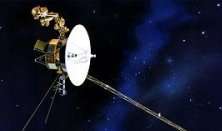Computer simulation predicts Voyager 2 will reach major milestone in space in late 2007-early 2008

Using a computer model simulation, Haruichi Washimi, a physicist at UC Riverside, has predicted when the interplanetary spacecraft Voyager 2 will cross the “termination shock,” the spherical shell around the solar system that marks where the solar wind slows down to subsonic speed.
According to Washimi’s simulations, the spacecraft is set to cross the termination shock in late 2007-early 2008. To make this forecast, Washimi and his colleagues used data from Voyager 2 and performed a global “magneto-hydrodynamic simulation” – a method that allows for precise and quantitative predictions of geomagnetic disturbances caused by solar activities.
Because Voyager 2’s crossing of the shock is expected to be an abrupt and relatively brief event, scientists are working to ensure that the most is made of the opportunity. With an idea of when the spacecraft will cross the shock, they are better able to maximize coverage of the crossing.
Study results appear in the Dec. 1 issue of The Astrophysical Journal.
“Washimi’s model has predicted the location of a boundary that is approximately 90 times farther from the sun than is the Earth, to within a few percent,” said Gary Zank, the director of the Institute of Geophysics and Planetary Physics and one of the coauthors of the research paper. “This is truly remarkable given the enormous complexity of the physics involved, the temporal and spatial scales involved, and the variability of the solar wind conditions.”
The solar wind – a stream of charged particles ejected by the sun in all directions – travels at supersonic speeds when it leaves the sun, until it eventually encounters the interstellar medium made up of plasma, neutral gas and dust.
At the termination shock, located at 7-8.5 billion miles from the sun, the solar wind is decelerated to less than the speed of sound. The boundary of the termination shock is not fixed, however, but wobbly, fluctuating in both time and distance from the sun, depending on solar activity.
“This is the first time the termination-shock position has been forecast in this way,” said Washimi, the lead author of the research paper and a scientist at the Institute of Geophysics and Planetary Physics. “After it crosses this boundary, Voyager 2 will be in the outer heliosphere beyond which lies the interstellar medium and galactic space. Our simulations also show that the spacecraft will cross the termination shock again in the middle of 2008. This will happen because of the back and forth movement of the termination-shock boundary. This means Voyager 2 will experience multiple crossings of the termination shock. These crossings will come to an end after the spacecraft escapes into galactic space.”
Voyager 2 was launched Aug. 20, 1977. It visited four planets and their moons in the course of its journey into space. Its sister spacecraft Voyager 1, which was launched Sept. 5, 1977, crossed the termination shock in December 2004 – earlier than Voyager 2 because of a shorter trajectory. Both spacecraft are currently operational, but power sources have degraded and some of the instrumentation no longer works optimally. In the future, the spacecraft will encounter their next milestone in space: the heliopause, which is the boundary where the interstellar medium brings the solar wind to a halt.
Source: University of California - Riverside





















